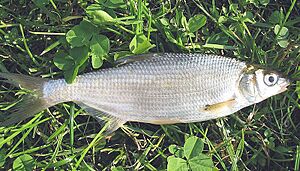Vimba vimba facts for kids
Quick facts for kids Vimba vimba |
|
|---|---|
 |
|
| Conservation status | |
| Scientific classification | |
| Synonyms | |
|
The Vimba (also known as the vimba bream) is a type of fish found in Europe. It belongs to the Cyprinidae family, which includes carps and minnows. This fish mostly lives in the sea. But every year, it swims up rivers to lay its eggs.
What Does the Vimba Look Like?
The Vimba fish looks a bit like a bream, but it's not as deep. It was once thought to be a type of bream because it has a long fin on its underside, called an anal fin. It also looks similar to an asp. However, the Vimba has a small mouth that is set back from its snout. An asp, on the other hand, has a large mouth with its lower jaw sticking out.
A Vimba usually grows to be about 25 to 45 centimetres (9.8 to 17.7 in) long. It can weigh up to 2 kilograms (4.4 lb). It has small scales, with about sixty of them forming a line along its side. This line is called the lateral line.
The Vimba is a deep bluish-green color on its back. Its sides are silvery. Its eyes are yellow. The fins on its chest (pectoral fins) and belly (pelvic fins) have reddish-yellow bases. During the breeding season, the colors of the Vimba become much brighter. Male Vimba fish might even have their gill covers (called the operculum), the bases of their fins, and their bellies turn orange.
Vimba Behaviour and Life Cycle
Vimba fish swim together in small groups called shoals along the coast of the sea. They search for invertebrates (small creatures without backbones) on the seabed to eat. They also eat the eggs of other fish.
In May or June, Vimba fish leave the sea. They swim up rivers to lay their eggs. They choose fast-moving parts of the river that have stony or gravelly bottoms and not much plant life. The male Vimba prepares several spots on the riverbed. The females then lay batches of their eggs in these spots.


